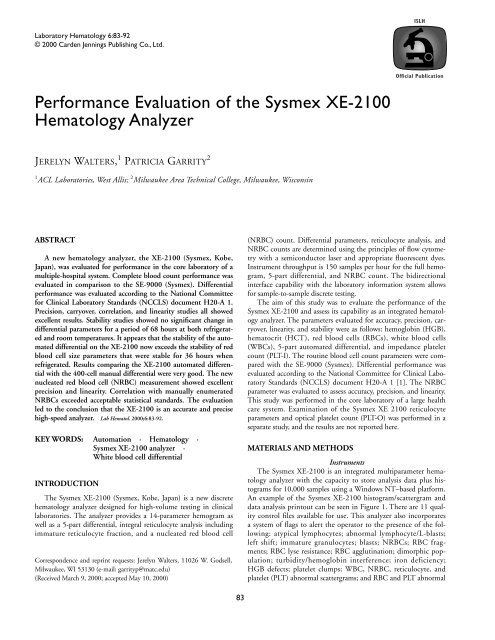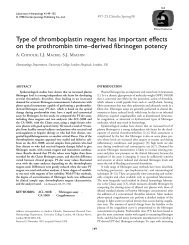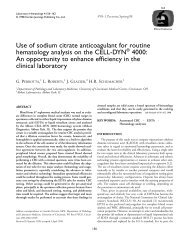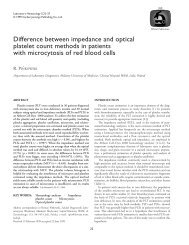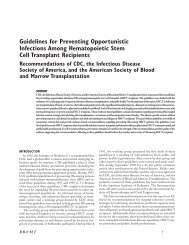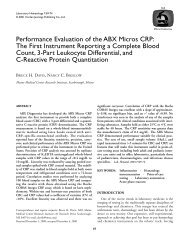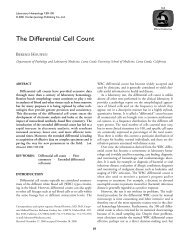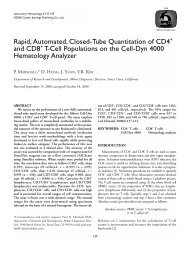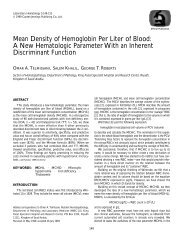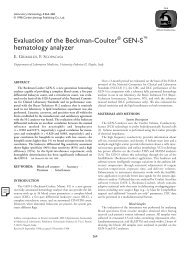Performance Evaluation of the Sysmex XE-2100 Hematology Analyzer
Performance Evaluation of the Sysmex XE-2100 Hematology Analyzer
Performance Evaluation of the Sysmex XE-2100 Hematology Analyzer
- No tags were found...
You also want an ePaper? Increase the reach of your titles
YUMPU automatically turns print PDFs into web optimized ePapers that Google loves.
ISLHLaboratory <strong>Hematology</strong> 6:83-92© 2000 Carden Jennings Publishing Co., Ltd.Official Publication<strong>Performance</strong> <strong>Evaluation</strong> <strong>of</strong> <strong>the</strong> <strong>Sysmex</strong> <strong>XE</strong>-<strong>2100</strong><strong>Hematology</strong> <strong>Analyzer</strong>JERELYN WALTERS, 1 PATRICIA GARRITY 21 ACL Laboratories, West Allis; 2 Milwaukee Area Technical College, Milwaukee, WisconsinABSTRACTA new hematology analyzer, <strong>the</strong> <strong>XE</strong>-<strong>2100</strong> (<strong>Sysmex</strong>, Kobe,Japan), was evaluated for performance in <strong>the</strong> core laboratory <strong>of</strong> amultiple-hospital system. Complete blood count performance wasevaluated in comparison to <strong>the</strong> SE-9000 (<strong>Sysmex</strong>). Differentialperformance was evaluated according to <strong>the</strong> National Committeefor Clinical Laboratory Standards (NCCLS) document H20-A 1.Precision, carryover, correlation, and linearity studies all showedexcellent results. Stability studies showed no significant change indifferential parameters for a period <strong>of</strong> 68 hours at both refrigeratedand room temperatures. It appears that <strong>the</strong> stability <strong>of</strong> <strong>the</strong> automateddifferential on <strong>the</strong> <strong>XE</strong>-<strong>2100</strong> now exceeds <strong>the</strong> stability <strong>of</strong> redblood cell size parameters that were stable for 36 hours whenrefrigerated. Results comparing <strong>the</strong> <strong>XE</strong>-<strong>2100</strong> automated differentialwith <strong>the</strong> 400-cell manual differential were very good. The newnucleated red blood cell (NRBC) measurement showed excellentprecision and linearity. Correlation with manually enumeratedNRBCs exceeded acceptable statistical standards. The evaluationled to <strong>the</strong> conclusion that <strong>the</strong> <strong>XE</strong>-<strong>2100</strong> is an accurate and precisehigh-speed analyzer. Lab Hematol. 2000;6:83-92.KEY WORDS: Automation · <strong>Hematology</strong> ·<strong>Sysmex</strong> <strong>XE</strong>-<strong>2100</strong> analyzer ·White blood cell differentialINTRODUCTIONThe <strong>Sysmex</strong> <strong>XE</strong>-<strong>2100</strong> (<strong>Sysmex</strong>, Kobe, Japan) is a new discretehematology analyzer designed for high-volume testing in clinicallaboratories. The analyzer provides a 14-parameter hemogram aswell as a 5-part differential, integral reticulocyte analysis includingimmature reticulocyte fraction, and a nucleated red blood cellCorrespondence and reprint requests: Jerelyn Walters, 11026 W. Godsell,Milwaukee, WI 53130 (e-mail: garrityp@matc.edu)(Received March 9, 2000; accepted May 10, 2000)(NRBC) count. Differential parameters, reticulocyte analysis, andNRBC counts are determined using <strong>the</strong> principles <strong>of</strong> flow cytometrywith a semiconductor laser and appropriate fluorescent dyes.Instrument throughput is 150 samples per hour for <strong>the</strong> full hemogram,5-part differential, and NRBC count. The bidirectionalinterface capability with <strong>the</strong> laboratory information system allowsfor sample-to-sample discrete testing.The aim <strong>of</strong> this study was to evaluate <strong>the</strong> performance <strong>of</strong> <strong>the</strong><strong>Sysmex</strong> <strong>XE</strong>-<strong>2100</strong> and assess its capability as an integrated hematologyanalyzer. The parameters evaluated for accuracy, precision, carryover,linearity, and stability were as follows: hemoglobin (HGB),hematocrit (HCT), red blood cells (RBCs), white blood cells(WBCs), 5-part automated differential, and impedance plateletcount (PLT-I). The routine blood cell count parameters were comparedwith <strong>the</strong> SE-9000 (<strong>Sysmex</strong>). Differential performance wasevaluated according to <strong>the</strong> National Committee for Clinical LaboratoryStandards (NCCLS) document H20-A 1 [1]. The NRBCparameter was evaluated to assess accuracy, precision, and linearity.This study was performed in <strong>the</strong> core laboratory <strong>of</strong> a large healthcare system. Examination <strong>of</strong> <strong>the</strong> <strong>Sysmex</strong> <strong>XE</strong> <strong>2100</strong> reticulocyteparameters and optical platelet count (PLT-O) was performed in aseparate study, and <strong>the</strong> results are not reported here.MATERIALS AND METHODSInstrumentsThe <strong>Sysmex</strong> <strong>XE</strong>-<strong>2100</strong> is an integrated multiparameter hematologyanalyzer with <strong>the</strong> capacity to store analysis data plus histogramsfor 10,000 samples using a Windows NT–based platform.An example <strong>of</strong> <strong>the</strong> <strong>Sysmex</strong> <strong>XE</strong>-<strong>2100</strong> histogram/scattergram anddata analysis printout can be seen in Figure 1. There are 11 qualitycontrol files available for use. This analyzer also incorporatesa system <strong>of</strong> flags to alert <strong>the</strong> operator to <strong>the</strong> presence <strong>of</strong> <strong>the</strong> following:atypical lymphocytes; abnormal lymphocyte/L-blasts;left shift; immature granulocytes; blasts; NRBCs; RBC fragments;RBC lyse resistance; RBC agglutination; dimorphic population;turbidity/hemoglobin interference; iron deficiency;HGB defects; platelet clumps; WBC, NRBC, reticulocyte, andplatelet (PLT) abnormal scattergrams; and RBC and PLT abnormal83
84 J.Walters and P. GarrityNegativeFIGURE 1. <strong>Sysmex</strong> <strong>XE</strong>-<strong>2100</strong> histogram/scattergram and data analysis printout. SFL indicates side fluorescent; SSC, side scatter;FSC, forward scatter; RF, radio frequency; DC, direct current; WBC, white blood cell; BASO, basophil; IMI, immature myeloidinformation; NRBC, nucleated red blood cell; RET, reticulocyte; PLT-O, optical platelet count; RBC, red blood cell; PLT, platelet;HGB, hemoglobin; HCT, hematocrit; MCV, mean corpuscular volume; MCH, mean corpuscular hemoglobin; MCHC, meancorpuscular hemoglobin concentration; RDW-SD, red blood cell distribution width by standard deviation; RDW-CV, red bloodcell distribution width by coefficient <strong>of</strong> variation; MPV, mean platelet volume; NEUT, neutrophil; LYMPH, lymphocyte;MONO, monocyte; EO, eosinophil; IRF, immature reticulocyte fraction; IP, interpretive.distribution. User-defined flags can be set to identify abnormalnumerical results. An example <strong>of</strong> <strong>the</strong> <strong>Sysmex</strong> <strong>XE</strong>-<strong>2100</strong> histogram/scattergramand data analysis printout for an abnormalsample can be seen in Figure 2. HGB determination is achievedusing <strong>the</strong> sodium lauryl sulfate (SLS)-hemoglobin method; SLSis a cyanide-free reagent.RBCs and PLT-I are enumerated in <strong>the</strong> RBC/PLT channelusing <strong>the</strong> sheath flow direct current (DC) detection method [2].HCT is simultaneously determined using <strong>the</strong> RBC pulse heightdetection method [3].The total and differential WBC counts are determined by flowcytometry, and each cell is analyzed by 3 different dispersion
<strong>Sysmex</strong> <strong>XE</strong>-<strong>2100</strong> <strong>Performance</strong> <strong>Evaluation</strong> 85WBC IP Message(s) RBC/RET P Message(s) PLT IP Message(s)Neutrophilia RET Abn Scattergram PLT Abnormal DistributionMonocytosisReticulocytosisLeukocytosisAnisocytosisNRBC PresentMacrocytosisImmature Gran?Left Shift?FIGURE 2. <strong>Sysmex</strong> <strong>XE</strong>-<strong>2100</strong> histogram/scattergram and data analysis printout: abnormal sample. Diff. Morph. indicates differentialmorphology. For o<strong>the</strong>r definitions, see legend to Figure 1.angles: forward-scattered light, lateral-scattered light, and lateralfluorescent light. The immature myeloid information (IMI) is aseparate channel that provides additional WBC information on<strong>the</strong> presence <strong>of</strong> immature granulocytes, blasts, and hematopoieticprogenitor cells. This channel uses a hemolytic reagent that selectivelyprotects immature cells that are analyzed by <strong>the</strong> radio frequency(RF)/DC detection method [4]. Nucleated RBCs aredetected in a separate flow channel using both a specific lysingreagent and a fluorescent dye.Reticulocytes are enumerated by flow cytometry using a semiconductorlaser and a nucleic acid fluorescent dye. The dye reactionis based on <strong>the</strong> same principle as that <strong>of</strong> <strong>the</strong> <strong>Sysmex</strong> R series reticulocyteanalyzers [5]. By analyzing both forward-scattered light andside fluorescence information, reticulocyte counts and reticulocytematurity information were obtained. A PLT-O count was also performedin this channel.The ability to perform platelet counts by 2 different technologiesprovides more accurate platelet information. The sheath flow
86 J.Walters and P. GarrityTABLE 1. Within-Run Precision (n = 10)*Sample 1 Sample 2 Sample 3 Sample 4 Sample 5Mean SD CV, %* Mean SD CV, % Mean SD CV, % Mean SD CV, % Mean SD CV, %Red blood cells, 10 6 /µL 4.19 0.03 0.7 4.66 0.03 0.6 3.81 0.02 0.5 4.13 0.03 0.7 4.58 0.01 0.2Hemoglobin, g/dL 12.1 0.06 0.5 14 0.05 0.4 12.5 0.03 0.2 12.6 0.00 0.0 13.3
<strong>Sysmex</strong> <strong>XE</strong>-<strong>2100</strong> <strong>Performance</strong> <strong>Evaluation</strong> 87TABLE 3. CarryoverParameter %White blood cells 0.0Red blood cells 0.4Hemoglobin 0.0Hematocrit 0.5Nucleated red blood cells 0.0Impedance platelet count 0.0PrecisionWithin-run precision was evaluated by performing 10 consecutivemeasurements on 5 fresh blood samples. Between-day precisionwas evaluated by processing commercial control over aperiod <strong>of</strong> 10 days.CarryoverCarryover was assessed using <strong>the</strong> International Committee forStandardization in <strong>Hematology</strong> (ICSH) procedure [9]. Carryoverwas performed by analyzing a specimen with a high concentrationconsecutively in triplicate (H1, H2, and H3) followed immediatelyby a low concentration consecutively in triplicate (L1, L2, and L3).The percentage <strong>of</strong> carryover for each parameter was calculatedusing <strong>the</strong> following formula:Carryover % = (L1 – L3) 100(H3 – L3)TABLE 4. LinearityParameter Range r 2White blood cellsHigh level 0.17 to 173.00 10 3 /µL 1.000Low level 0 to 1.12 10 3 /µL 1.000Impedance platelet countHigh level 1 to 2054 10 6 /µL 0.998Low level 0 to 382 10 6 /µL 1.000HemoglobinHigh level 0.0 to 26.6 g/dL 1.000Low level 0.0 to 10.3 g/dL 1.000HematocritHigh level 0.2% to 81.4% 1.000Low level 0.1% to 30.1% 1.000Red blood cellsHigh level 0.92 to 9.23 10 6 /µL 0.997Low level 0.01 to 3.48 10 6 /µL 1.000making a 400-cell manual differential impractical. The hemogramand autodifferential results were evaluated using regression analysis.Two blood films were made and stained with a polychromestain. Manual differentials were performed on each sampleaccording to <strong>the</strong> NCCLS document H20-A 1 [1]. Manual differ-ALinearityLow linearity was evaluated by serial dilution technique <strong>of</strong>fresh patient samples. The analyzer’s primary diluting fluidwas used as <strong>the</strong> diluent. High linearity was evaluated usingboth fresh patient samples and concentrated samples. Serialdilutions were performed as stated above. Extended PLT-I linearitywas evaluated with a platelet concentrate sample dilutedwith WBCs and platelet-depleted RBCs.StabilityShort-term stability. Blood was collected from 6 normaldonors and stored at room temperature. The samples wereanalyzed in duplicate on <strong>the</strong> <strong>Sysmex</strong> <strong>XE</strong>-<strong>2100</strong> at 0, 15, 30, 45,and 60 minutes.Long-term stability. Blood was collected from 10 normal donorsand divided into 19 aliquots. Nine aliquots were stored at 4°C, and9 aliquots were stored at room temperature. The remaining aliquotwas tested immediately. At 4, 8, 12, 16, 24, 36, 48, 56, and68 hours after collection, 1 aliquot each from room temperatureand 4°C was analyzed. All aliquots stored at 4°C were allowed towarm to room temperature before analysis.ComparabilityThere were 200 random blood samples selected from <strong>the</strong> dailyworkload and analyzed on <strong>the</strong> <strong>Sysmex</strong> <strong>XE</strong>-<strong>2100</strong> and <strong>Sysmex</strong> SE-9000. An additional 12 samples were excluded from <strong>the</strong> studybecause <strong>of</strong> incomplete or missing data. Two additional sampleswere excluded because <strong>the</strong> WBC counts were
88 J.Walters and P. Garrity<strong>XE</strong>-<strong>2100</strong> NEUTROPHIL #<strong>XE</strong>-<strong>2100</strong> LYMPHOCYTE #FIGURE 4. Autodifferential linearity. A. Neutrophils. B. Lymphocytes. C. Monocytes.ential results were compared with <strong>the</strong> autodifferential resultsusing linear regression analysis.NRBC MeasurementLinearity and precision were evaluated using a whole bloodpatient sample with >40,000 NRBCs/µL. Accuracy was assessedusing <strong>the</strong> following comparisons:• <strong>Sysmex</strong> <strong>XE</strong>-<strong>2100</strong> absolute NRBC number with <strong>the</strong> absoluteNRBC number calculated from a 400-cell manual differential.• <strong>Sysmex</strong> <strong>XE</strong>-<strong>2100</strong> WBC count with <strong>the</strong> total nucleated cell countmanually corrected for presence <strong>of</strong> NRBCs.• <strong>Sysmex</strong> <strong>XE</strong>-<strong>2100</strong> WBC count with a total nucleated cell countobtained on <strong>the</strong> <strong>Sysmex</strong> F-300. This total nucleated cell countincludes NRBCs.RESULTSPrecisionResults from within-run replicate analyses <strong>of</strong> blood samplesare shown in Table 1. The precision surpassed manufacturer specificationsfor all parameters. All measured RBC parametersshowed excellent precision, with coefficients <strong>of</strong> variation (CVs)
<strong>Sysmex</strong> <strong>XE</strong>-<strong>2100</strong> <strong>Performance</strong> <strong>Evaluation</strong> 89FIGURE 5. Long-term stability: room temperature. WBC indicates white blood cell.Long-term stability results for refrigerated storage are shown inFigure 6.ComparabilityThe comparison <strong>of</strong> results between <strong>the</strong> <strong>Sysmex</strong> <strong>XE</strong>-<strong>2100</strong> and<strong>the</strong> <strong>Sysmex</strong> SE-9000 showed excellent correlation for all parametersexcept absolute number <strong>of</strong> basophils (Table 5). Comparison <strong>of</strong> <strong>the</strong><strong>Sysmex</strong> <strong>XE</strong>-<strong>2100</strong> automated differential with <strong>the</strong> 400-cell manualdifferential showed good correlation (Table 6).NRBCsThe sample with elevated NRBCs analyzed 10 times gave CVs<strong>of</strong> 1.05% for absolute number <strong>of</strong> NRBCs and 1.37% for adjustedWBCs. The NRBC parameter showed acceptable linearity up to45,960/µL (Figure 7). NRBC number per µL determined by <strong>the</strong><strong>Sysmex</strong> <strong>XE</strong>-<strong>2100</strong> showed excellent correlation with <strong>the</strong> NRBCnumber per µL calculated from <strong>the</strong> 400-cell manual differentialand <strong>the</strong> total nucleated cell count (Figure 8).The corrected WBC count reported by <strong>the</strong> <strong>Sysmex</strong> <strong>XE</strong>-<strong>2100</strong>compared well with <strong>the</strong> manually corrected WBC count based on<strong>the</strong> 400-cell differential (Figure 9). The corrected WBC countreported by <strong>the</strong> <strong>Sysmex</strong> <strong>XE</strong>-<strong>2100</strong> showed poor correlation with <strong>the</strong>uncorrected total nucleated cell count (Figure 10).DISCUSSIONThe <strong>Sysmex</strong> <strong>XE</strong>-<strong>2100</strong> performed exceptionally well for <strong>the</strong>parameters evaluated. Results for precision and carryover studiesexceeded manufacturer specifications. There was excellent correlationbetween instruments for <strong>the</strong> measured parameters (HGB,HCT, RBCs, PLT-I, WBCs, and automated differential). The poorbasophil correlation was not unexpected because <strong>of</strong> very lowabsolute numbers <strong>of</strong> basophils.Results for linearity were very good. WBCs and PLT-I showedexcellent linearity over a wide range (WBCs, 0 to 400,000/µL;PLT-I, 0 to 9,000,000/µL). Extended low linearity <strong>of</strong> <strong>the</strong> automateddifferential parameters (neutrophils, lymphocytes, and monocytes)provides a significant advantage when analyzing leukopenic samples.Short-term stability studies showed <strong>the</strong>re is no immediate timelimitation on accuracy <strong>of</strong> results. Long-term stability studies showed
<strong>Sysmex</strong> <strong>XE</strong>-<strong>2100</strong> <strong>Performance</strong> <strong>Evaluation</strong> 91TABLE 6. Comparison <strong>of</strong> Manual Differential With <strong>XE</strong>-<strong>2100</strong>MinimumMaximumManual <strong>XE</strong>-<strong>2100</strong> Manual <strong>XE</strong>-<strong>2100</strong> Correlation Coefficient Slope InterceptNeutrophils, % 5.5 4.9 98.0 97.0 0.970 0.980 –0.87Lymphocytes, % 2.0 1.8 93.0 93.1 0.970 0.960 2.28Monocytes, % 0.0 0.0 23.5 30.7 0.850 0.999 1.01Eosinophils, % 0.0 0.0 10.5 11.8 0.900 0.980 0.04Basophils, % 0.0 0.0 7.0 4.1 0.650 0.500 0.15impressive precision <strong>of</strong> <strong>the</strong> automated differential parameters foralmost 3 days. The stability <strong>of</strong> <strong>the</strong> automated differential exceeds<strong>the</strong> stability <strong>of</strong> RBC measurements. Thus, <strong>the</strong> MCV/HCT are now<strong>the</strong> limiting factors in sample stability for hematologic analysis.These parameters were stable at refrigerated temperatures for approximately36 hours. Room temperature storage limits stability to a period<strong>of</strong> 12 to 24 hours.Comparability <strong>of</strong> <strong>the</strong> 400-cell manual differential with <strong>the</strong> <strong>Sysmex</strong><strong>XE</strong>-<strong>2100</strong> automated differential was good, including results <strong>of</strong>low-level cell types (monocytes, eosinophils, and basophils).Because <strong>of</strong> <strong>the</strong> increased accuracy <strong>of</strong> <strong>the</strong> automated differential, <strong>the</strong>screening potential <strong>of</strong> <strong>Sysmex</strong> <strong>XE</strong>-<strong>2100</strong> has been enhanced.The new technology to measure NRBCs appears to be anextremely accurate and precise parameter. Good correlation hasbeen shown between <strong>the</strong> corrected WBC on <strong>the</strong> <strong>Sysmex</strong> <strong>XE</strong>-<strong>2100</strong>and <strong>the</strong> manually corrected total nucleated cell count. The poorcorrelation seen between <strong>the</strong> <strong>Sysmex</strong> <strong>XE</strong>-<strong>2100</strong>–corrected WBCcount with <strong>the</strong> uncorrected total nucleated cell count is fur<strong>the</strong>r evidencethat <strong>the</strong> <strong>Sysmex</strong> <strong>XE</strong>-<strong>2100</strong> provides an accurate WBC countin <strong>the</strong> presence <strong>of</strong> NRBCs. The functionality <strong>of</strong> having both anFIGURE 7. Nucleated red blood cell (NRBC) linearity.FIGURE 9. White blood cell (WBC) correlation: <strong>Sysmex</strong> <strong>XE</strong>-<strong>2100</strong> corrected WBC count versus manually corrected WBCcount.FIGURE 8. Nucleated red blood cell (NRBC) correlation: <strong>Sysmex</strong><strong>XE</strong>-<strong>2100</strong> NRBC count versus calculated NRBC countfrom differential and total nucleated cell count.FIGURE 10. White blood cell (WBC) correlation: <strong>Sysmex</strong> <strong>XE</strong>-<strong>2100</strong> corrected WBC count versus uncorrected total nucleatedcell count.
92 J.Walters and P. Garrityaccurate WBC count and differential and an absolute number <strong>of</strong>NRBCs is a significant progression in automated hematology. Thistechnological advance substantially reduces <strong>the</strong> need for manualintervention on <strong>the</strong>se abnormal samples.In conclusion, <strong>the</strong> <strong>Sysmex</strong> <strong>XE</strong>-<strong>2100</strong> has proven to be an accurateand precise high-speed analyzer. It is a suitable analyzer forboth high-volume laboratories and laboratories that test manyabnormal samples. The stability and precision <strong>of</strong> <strong>the</strong> automateddifferential enhances its application as a screening analyzer andreduces <strong>the</strong> need for manual differentials.REFERENCES1. National Committee for Clinical Laboratory Standards (NCCLS). ReferenceLeukocyte Differential Count (Proportional) and <strong>Evaluation</strong> <strong>of</strong> InstrumentMethods. Wayne, PA: NCCLS Document H20-A 1; 1992.2. Thom R, Hampe A, Sauerbrey G. Die elektronische volumenbestimmungvon blutkörperchen und ihre fehlerquellen [Electronic determination <strong>of</strong><strong>the</strong> volume <strong>of</strong> blood corpuscles and its sources <strong>of</strong> errors]. Z Gesamte ExpMed. 1969;151:331-349.3. Jones AR. Counting and sizing <strong>of</strong> blood cells using aperture–impedancesystems. In: van Assendelft OW, England JM, eds. Advances inHematological Methods: The Blood Count. Boca Raton, FL: CRC Press;1982:59-63.4. Fujimoto K. Principles <strong>of</strong> measurement in hematology analyzers manufacturedby <strong>Sysmex</strong> Corporation. <strong>Sysmex</strong> J Int. 1999;9:31-40.5. Hohenwallner W, Wiesinger K, Wimmer E. The reticulocytes: automaticcounting, indication and interpretation. <strong>Sysmex</strong> J Int. 1992;2:120-135.6. Cornbleet J. Spurious results from automated hematology cell counters.Lab Med. 1983;14:509-514.7. TOA Medical Electronics. <strong>Sysmex</strong> SE-9000 System Operation Manual.Kobe, Japan: TOA Medical Electronics; 1994.8. TOA Medical Electronics. <strong>Sysmex</strong> <strong>XE</strong>-<strong>2100</strong> System Operation Manual.Kobe, Japan: TOA Medical Electronics; 1999.9. International Committee for Standardization in <strong>Hematology</strong> (ICSH). Protocolfor evaluation <strong>of</strong> automated hematology analyzer. ICSH. 1984;6:69.


